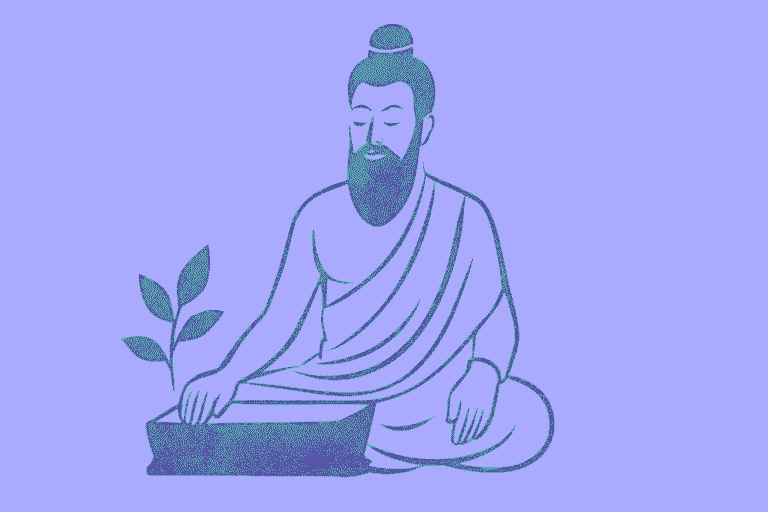contact@cayeit.com
The cold winter months often bring sniffling noses, dry skin, and recurring colds and flus. According to Ayurveda, winter aggravates the Vata dosha, which governs movement in the body and mind. An accumulation of Vata in winter can manifest as anxiety, constipation, dry skin, brittle hair, irregular hunger, aches and pains, and overall fatigue. Luckily, Ayurveda provides wisdom for how to counteract these effects and maintain balance in the winter season. With a few adjustments to diet, lifestyle, yoga practice, and daily routine, you can harness nature’s intelligence to fortify your body against winter’s harshness. In this comprehensive guide, learn how to implement Ayurvedic tips to enjoy the winter season in a warm, healthy, and happy way.
Follow the Ritucharya Diet
A cornerstone of Ayurveda is “ritucharya,” which translates to “seasonal routine.” This emphasizes adjusting food choices and eating habits to align with the current season. Winter is part of the cool, dry season that depletes warmth and moisture from the body. Therefore, the Ayurvedic diet in winter focuses on nourishing foods and spices that provide internal heat, hydration, healthy fats, and grounding qualities.
Some recommended foods and spices to include generously in your winter diet are:
- Warm and cooked foods like soups, stews, porridge
- Healthy fats like ghee, olive oil, nuts, avocado
- Grounding grains like rice, quinoa, sweet potatoes
- Cooked vegetables like beets, carrots, onions, garlic
- Warming spices like ginger, garlic, turmeric, cinnamon, cardamom
- Hydrating foods like brothy soups, roasted root veggies, cooked apples and pears
Foods to minimize include raw and cold foods like salads and smoothies, drying foods like crackers and chips, icy cold drinks, and frozen desserts. Lighten up on cold dairy like yogurt, cheese, and milk as well. Stick to lighter evening meals to avoid taxing digestion overnight. Overall, allow your digestive fire to stoke by choosing seasonal foods that provide stable nourishment without overwhelming agni.
Establish a Protective Daily Routine
Ayurveda provides a structured daily routine called dinacharya designed to keep the doshas balanced throughout changing seasons. Make these practices a part of your morning ritual in winter:
- Rise before or at sunrise to sync your body with nature’s cycles
- Hydrate with a glass of warm water with lemon
- Scrape your tongue
- Rinse your nose and sinuses with warm salty water
- Massage warm oil like sesame, almond, coconut into dry skin
- Bathe using gentle cleansers and moisturize skin after
- Move your body with sun salutations and light yoga poses
- Meditate to calm the mind
- Eat a nourishing warm breakfast like oatmeal
Also take care to get sufficient restorative rest before 10pm when metabolism winds down. Counter the longer winter nights by heading to bed an hour earlier. Establishing this protective routine fortifies immunity and nourishes body, mind and spirit through winter.
Herbal Support
Ayurvedic herbs provide potent medicine for bolstering defences pre-emptively. Many adaptogenic herbs boost ojas to nourish immunity while counteracting the Vata imbalances of winter. Try these healing herbs, after the advice of Ayurveda expert :
Ashwagandha: This quintessential adaptogen enhances ojas while soothing the nervous system. Its grounding energy helps counter Vata. Take 500-1000 mg per day.
Guduchi: This anti-inflammatory and immune-modulating herb supports immune health and vitality. Take 1-2 grams per day.
Shatavari: The nurturing female tonic Shatavari boosts immunity and nourishment. It also rehydrates dry tissues. Take 1-2 grams per day.
Licorice root: This lung tonic helps expel mucus to support respiratory health. Take 1-2 grams per day.
Turmeric: The antioxidant and anti-inflammatory effects of turmeric help regulate immunity. Take 500-1000 mg per day.
Ginger: This warming herb kindles agni digestive fire to prevent Vata and Ama accumulation. Take 1-3 grams per day.
Tulsi: Holy basil provides adaptogenic energy and respiratory support through its antimicrobial effects. Take 2-4 grams per day.
Triphala: This classic Ayurvedic formula gently detoxes the guts to prevent toxin buildup. Take 1-2 grams before bed.
Healthy Oils for Massage
Massaging oil into the skin deeply hydrates while calming the nervous system. Choose these Ayurvedic oils to protect skin health in dry winter air:
- Coconut oil moisturizes skin excellently. Its cool virya energy balances Pitta and Vata.
- Sesame oil nourishes and grounds the body in its sweet, warming nature. It lubricates joints and stimulates circulation.
- Almond oil relieves dry skin and muscle tightness through its heavy, emollient qualities.
- Mustard oil stimulates circulation and warmth when massaged into joints and muscles. Its pungent virya helps counter Vata.
- Castor oil supports lymphatic flow and detoxification when applied topically. It also enhances circulation.
Give yourself a daily Abhyanga massage by oiling your entire body from head to toe before bathing. This traditional practice nourishes skin, stimulates circulation, and deeply relaxes the nervous system.
Yoga for the Winter Season
Adjust your yoga practice in cooler months to match winter’s influence. These tips will help you stay centred.
Focus on heating, stimulating yoga poses to stoke inner fire like:
- Surya Namaskar (Sun salutations)
- Phalakasana (Plank pose)
- Vasisthasana (Side plank)
- Virasana (Hero pose)
- Ustrasana and Bitilasana (Kneeling poses like camel and cat/cow)
- Warm up joints with circles and hip openers
Follow with restorative poses that calm Vata like:
- Paschimottanasana (Forward folds)
- Salamba Setu Bandhasana (Supported bridge pose)
- Viparita Karani (Legs up the wall)
- Jathara Parivartanasana (Supine twists like knee to chest)
Pranayama breathing exercises help direct prana energy for balance:
- Kapalabhati cleans the lungs of excess Vata
- Bhramari humming soothes the mind
- Ujjayi smooths out erratic Vata energy
Savasana relaxation pose allows body and mind to absorb the practice’s benefits.
Keep your practice grounded, inward, and soft. Flow through poses gently without pushing excessively hard. The heating solar energy of many sun salutations practice provides an excellent antidote to winter.
Meditation for Mind-Body Balance
The inward winter energy lends itself perfectly to a meditation practice. Aim for 2 x 20 minute sessions per day. Choose calming, heart-centered meditations to relieve Vata anxiety and spaciness:
- Mindfulness to settle scattered thoughts
- Loving-kindness to relax the mind
- ‘Om’ chanting to channel prana calmly
- Heart-chakra meditations to open feelings of joy and compassion
Let periods of silence also heal and integrate your consciousness. The winter quiet allows deep introspection into your true essence beyond thoughts. Natural lighting is optimal for daily meditation.
Lifestyle Adjustments
Make these seasonal tweaks to your daily lifestyle:
- Keep adequately warm with extra layers indoors and a cloak or overcoat outside. Cover your head, ears and neck.
- Give excessive cold drafts. Chilliness aggravates Vata, so maintain cozy warmth around you.
- Stay active with regular exercise to stoke agni and circulation. Move daily to avoid stagnation.
- Take lunch as your biggest meal when digestion is strongest.
- Stay hydrated by sipping warm water with lemon throughout the day.
- Apply sesame oil to nostrils daily to lubricate dry nasal passages.
- Adopt early bedtimes to sync with longer nights. Rest deeply.
- Stay connected with community and loved ones. Social isolation aggravates Vata.
- Diffuse warming essential oils like cinnamon, clove, rosemary and thyme to scent your home.
- Avoid cold, windy weather outside. If you must go out, bundle up fully and cover your head, neck and ears.
- Give yourself daily oil massages before bathing to provide comfort, stimulation and hydration.
- Take vacations in warmer climates to restore from winter’s harshness whenever possible.
- Receive deep-tissue massages frequently to relieve accumulated body aches.
- Engage relaxing hobbies like reading, writing, listening to music, and creativity.
Special Considerations for Women
Women need extra care during winter’s coldness:
- Maintain body warmth daily through proper clothing, activity, nutrition and oil massage.
- Support hormonal balance with herbs like shatavari, ashwagandha, guduchi, aloe vera. These build ojas to counteract Vata and nurture female physiology.
- Apply castor oil packs over the lower abdomen to ease menstrual cramps and premenstrual syndrome.
- Hydrate with plenty of warm, cooked foods like grains and root vegetables.
- Avoid cold, raw foods which provoke cramping and pain.
- Take iron-rich herbs like spirulina, moringa or chlorella if you feel anemia or fatigue. Deficiencies are common when menstruating.
- Reduce heavy exercise during menstruation and ovulation. Gentle movement relieves aches.
- Apply sesame oil and gentle heat through hot water bottles to soothe pelvic discomfort.
- Massage lower abdomen and sacrum with warm castor oil daily before menses for a smooth flow.
- Support emotional balance through yoga, breathwork, meditation, journaling, and talking with close friends and community.
Conclusion
Winter need not be a time of hardship and illness if you align yourself with nature’s intelligence. Through Ayurveda’s timeless teachings, you can remain vibrant, warm, and energetic even in cold months. This annual cycle of seasonal change provides a profound opportunity for self-renewal. By implementing an Ayurvedic winter routine, you will discover deep nourishment, tranquillity and wellbeing within. You may find your health and happiness blooming beautifully under winter’s quiet blanket.





